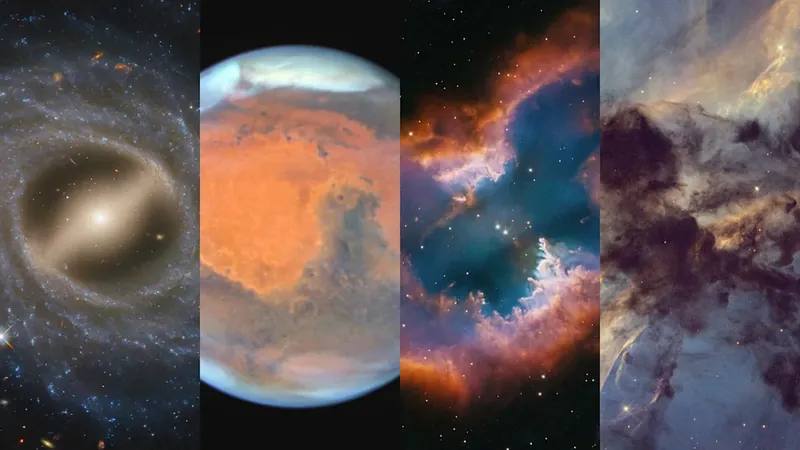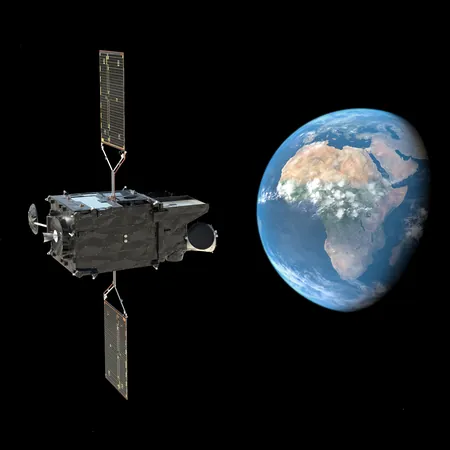
Hubble's 35-Year Legacy: Stunning New Views from the Cosmic Frontier
2025-04-24
Author: Amelia
After an awe-inspiring 35 years in orbit, the Hubble Space Telescope continues to dazzle scientists and stargazers alike with breathtaking images of the universe and its many enigmas.
Launched aboard the Space Shuttle Discovery on April 24, 1990, Hubble has been at the forefront of astronomical breakthroughs. As NASA and the European Space Agency mark this momentous anniversary, they unveil remarkable new images that showcase Hubble's enduring legacy.
Shawn Domagal-Goldman, acting director of NASA's Astrophysics Division, emphasizes the telescope's significance: 22Hubble opened a new window to the universe when it launched 35 years ago. Its stunning imagery inspired people across the globe, and the data behind those images revealed surprises about everything from early galaxies to planets in our own solar system.22 He also notes the telescope's ongoing operation as crucial for future missions, such as the Habitable Worlds Observatory.
Hubble has captured spectacular images of not only our solar system's planets and moons but also distant worlds orbiting other stars. It has enabled astronomers to study the formation of exoplanets, analyze starlight filtering through alien atmospheres, and detect vital signatures like water vapor and organic materials—an essential step in understanding potential habitats for life.
New Cosmic Highlights to Celebrate Hubble's Anniversary
Here are some of the latest captivating images released to commemorate this storied landmark.
A Closer Look at Mars
In late December 2024, as Mars approached its closest position to Earth in two years, Hubble captured two stunning views of the Red Planet over a span of just 17 hours. The images reveal Mars' iconic features, such as the enormous Olympus Mons volcano and the sprawling Valles Marineris canyon.
The Ethereal NGC 2899 Nebula
On January 8, 2025, Hubble revealed the striking planetary nebula NGC 2899, showcasing its unique cylindrical outflow of gas shaped by a central white dwarf star's intense radiation. This celestial masterpiece, roughly 4,500 light-years away, features glowing hydrogen and oxygen and is sculpted by possible companion stars.
The Dark Secrets of the Rosette Nebula
Captured on December 27, 2024, a section of the Rosette Nebula exemplifies the cosmic artistry of stellar formation. Dark hydrogen gas clouds are brilliantly lit by radiation from central star clusters, creating a breathtaking cosmic spectacle filled with vibrant colors from hydrogen, oxygen, and nitrogen.
The Flocculent Barred Spiral Galaxy NGC 5335
This patchy spiral galaxy, located in Virgo, differs vastly from our Milky Way with its sporadic star formations and distinctive bar structure. NASA highlights that such bars may play a dynamic role in channeling gas towards galactic centers, fueling star creation.
NGC 346: A Stellar Sculpting Ground
The young star cluster NGC 346 in the Small Magellanic Cloud is a vibrant formation site, showcasing intense stellar activity that shapes its surrounding nebula. This recent image captures the grandeur of starlight illuminating the dense gas, hinting at the cluster's youthful energy.
Despite the emergence of the more powerful James Webb Space Telescope, Hubble retains its unique position by complementing Webb's infrared vision with ultraviolet and visible light observations—allowing us to experience the universe much like the human eye would.
As we continue to uncover the universe's secrets, Hubble's legacy is not just enduring but also evolving, proving that even at 35, it is still a vital player in the cosmic narrative.









 Brasil (PT)
Brasil (PT)
 Canada (EN)
Canada (EN)
 Chile (ES)
Chile (ES)
 Česko (CS)
Česko (CS)
 대한민국 (KO)
대한민국 (KO)
 España (ES)
España (ES)
 France (FR)
France (FR)
 Hong Kong (EN)
Hong Kong (EN)
 Italia (IT)
Italia (IT)
 日本 (JA)
日本 (JA)
 Magyarország (HU)
Magyarország (HU)
 Norge (NO)
Norge (NO)
 Polska (PL)
Polska (PL)
 Schweiz (DE)
Schweiz (DE)
 Singapore (EN)
Singapore (EN)
 Sverige (SV)
Sverige (SV)
 Suomi (FI)
Suomi (FI)
 Türkiye (TR)
Türkiye (TR)
 الإمارات العربية المتحدة (AR)
الإمارات العربية المتحدة (AR)